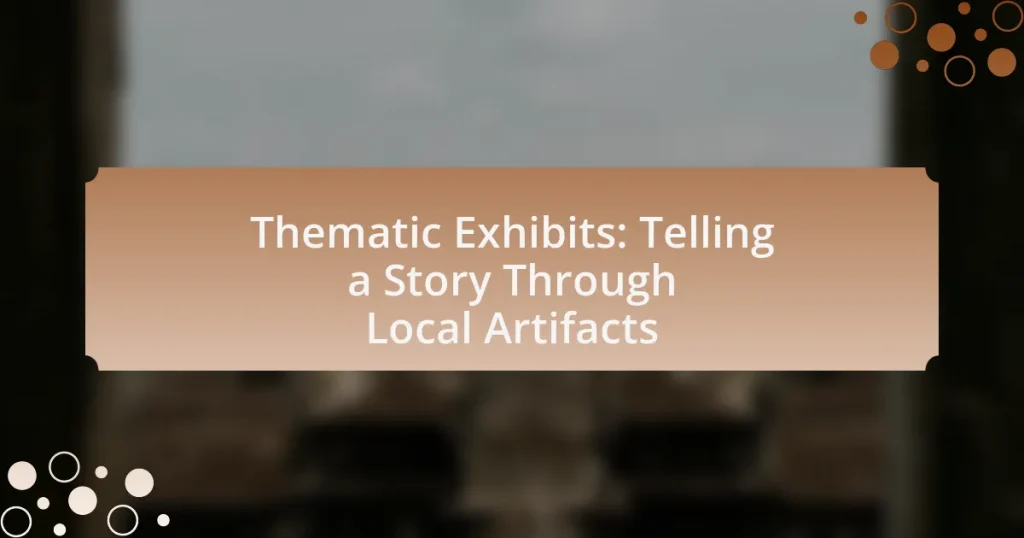Thematic exhibits are curated displays that focus on specific themes or narratives, utilizing local artifacts to convey cultural, historical, or artistic significance. This article explores how these exhibits engage audiences by telling stories through tangible connections to local heritage, emphasizing the importance of relevant artifacts in creating compelling narratives. Key components for successful thematic exhibits include clear themes, engaging storytelling, interactive elements, and effective layout, all aimed at enhancing visitor experience and education. Additionally, the article addresses the challenges curators face in exhibit design and the best practices for ensuring accessibility and audience engagement.
What are Thematic Exhibits and Their Purpose?
Thematic exhibits are curated displays that focus on a specific theme or narrative, often utilizing local artifacts to convey a story or message. Their purpose is to engage audiences by providing a cohesive experience that highlights cultural, historical, or artistic significance related to the chosen theme. For example, a thematic exhibit on local history might showcase artifacts from a particular time period, allowing visitors to connect with the past in a meaningful way. This approach not only educates but also fosters a deeper appreciation for the community’s heritage and identity.
How do Thematic Exhibits tell a story through local artifacts?
Thematic exhibits tell a story through local artifacts by curating items that reflect the cultural, historical, and social narratives of a specific community. Each artifact serves as a tangible connection to the past, allowing visitors to engage with the unique experiences and traditions of the locality. For instance, a thematic exhibit focused on a region’s agricultural history might include tools, photographs, and personal accounts from local farmers, illustrating the evolution of farming practices and their impact on the community. This approach not only educates the audience but also fosters a sense of identity and belonging by highlighting the significance of local heritage.
What elements are essential for creating a compelling narrative in a thematic exhibit?
Essential elements for creating a compelling narrative in a thematic exhibit include a clear theme, engaging storytelling, contextual artifacts, and interactive elements. A clear theme provides a focused message that guides the narrative, while engaging storytelling captivates the audience’s attention and fosters emotional connections. Contextual artifacts enhance the narrative by providing tangible connections to the theme, and interactive elements encourage visitor participation, making the experience more memorable. These components work together to create an immersive and educational experience that resonates with visitors.
How do local artifacts enhance the storytelling aspect of thematic exhibits?
Local artifacts enhance the storytelling aspect of thematic exhibits by providing tangible connections to the cultural and historical narratives being presented. These artifacts serve as physical evidence of the themes being explored, allowing visitors to engage more deeply with the subject matter. For instance, a thematic exhibit on indigenous cultures may include tools, clothing, or art created by local tribes, which not only illustrate the daily lives and practices of these communities but also evoke emotional responses and foster a sense of authenticity. Research indicates that exhibits incorporating local artifacts can increase visitor retention of information by up to 40%, as they create a more immersive and relatable experience.
Why are local artifacts significant in thematic exhibits?
Local artifacts are significant in thematic exhibits because they provide authentic connections to the cultural, historical, and social narratives of a specific community. These artifacts serve as tangible representations of local heritage, allowing visitors to engage with the unique stories and experiences that shape a region’s identity. For instance, a thematic exhibit focused on indigenous cultures may include tools, clothing, and art created by local tribes, which not only illustrate traditional practices but also foster a deeper understanding of the community’s values and beliefs. This direct representation enhances the educational impact of the exhibit, making the local context more relatable and meaningful for the audience.
What role do local artifacts play in preserving cultural heritage?
Local artifacts play a crucial role in preserving cultural heritage by serving as tangible representations of a community’s history, traditions, and identity. These artifacts provide insights into the daily lives, beliefs, and practices of past generations, allowing current and future generations to connect with their cultural roots. For instance, archaeological findings, such as pottery or tools, can reveal information about the social structure and economic activities of ancient societies. Additionally, local artifacts often become focal points in museums and thematic exhibits, where they are contextualized within narratives that educate the public about their significance. This educational aspect reinforces the importance of cultural heritage and fosters a sense of pride and continuity within communities.
How do local artifacts connect communities to their history?
Local artifacts connect communities to their history by serving as tangible representations of cultural heritage and shared experiences. These objects, such as tools, clothing, and art, provide insights into the daily lives, traditions, and values of past generations. For example, a community may display artifacts from a significant historical event, allowing residents to engage with their collective memory and fostering a sense of identity. Research indicates that communities with active engagement in preserving and showcasing local artifacts experience stronger social cohesion and a deeper understanding of their historical context, as evidenced by studies conducted by the American Alliance of Museums, which highlight the role of artifacts in enhancing community identity and pride.
What are the key components of a successful Thematic Exhibit?
The key components of a successful thematic exhibit include a clear theme, engaging storytelling, relevant artifacts, interactive elements, and effective layout. A clear theme provides focus and direction, ensuring that all elements of the exhibit align with the central message. Engaging storytelling captivates visitors, making the experience memorable and meaningful. Relevant artifacts are essential as they provide tangible connections to the theme, enhancing authenticity. Interactive elements encourage visitor participation, fostering a deeper understanding and connection to the content. Finally, an effective layout organizes the exhibit in a way that guides visitors through the narrative, ensuring a cohesive and enjoyable experience.
How is the theme of a thematic exhibit determined?
The theme of a thematic exhibit is determined through a combination of the exhibit’s objectives, the target audience, and the narrative that the curator aims to convey. Curators analyze the artifacts available, their historical and cultural significance, and how they relate to the overarching story intended for the exhibit. This process often involves research into local history and community interests to ensure relevance and engagement. For instance, an exhibit focused on local artifacts may center around a specific historical event or cultural practice, thereby guiding the selection and presentation of items to create a cohesive narrative that resonates with visitors.
What factors influence the selection of a theme for a thematic exhibit?
The selection of a theme for a thematic exhibit is influenced by several key factors, including audience interest, relevance to local culture, and the availability of artifacts. Audience interest drives engagement, ensuring that the theme resonates with visitors and encourages attendance. Relevance to local culture ensures that the exhibit reflects the community’s history and values, fostering a sense of connection. Additionally, the availability of artifacts is crucial, as a theme must be supported by tangible items that can effectively illustrate the narrative. These factors collectively ensure that the thematic exhibit is both meaningful and educational.
How can themes be effectively communicated to the audience?
Themes can be effectively communicated to the audience by utilizing clear narratives and engaging visuals that resonate with the audience’s experiences. For instance, thematic exhibits can incorporate local artifacts that tell a cohesive story, allowing visitors to connect emotionally and intellectually with the theme. Research shows that storytelling enhances audience engagement; a study by the University of California found that narratives can increase retention of information by up to 65%. By integrating artifacts that reflect the theme, such as historical objects or cultural items, the exhibit can create a tangible link to the narrative, making the theme more relatable and memorable for the audience.
What types of local artifacts are commonly used in thematic exhibits?
Local artifacts commonly used in thematic exhibits include historical documents, traditional clothing, tools, pottery, and artwork. These artifacts serve to illustrate the cultural, social, and economic aspects of a community’s history. For example, historical documents can provide insights into significant events, while traditional clothing reflects the customs and practices of a specific time period. Tools and pottery often showcase the technological advancements and daily life of past societies. Artwork can convey the aesthetic values and beliefs of a culture, enriching the narrative presented in the exhibit.
How do different types of artifacts contribute to the overall theme?
Different types of artifacts contribute to the overall theme by providing tangible connections to cultural narratives and historical contexts. For instance, tools, clothing, and art pieces each represent specific aspects of a community’s lifestyle, values, and traditions, thereby enriching the thematic narrative of an exhibit. Historical artifacts, such as indigenous tools, can illustrate technological advancements and cultural practices, while artistic artifacts can convey emotional and aesthetic expressions unique to a culture. This multifaceted representation allows visitors to engage with the theme on various levels, enhancing their understanding and appreciation of the local heritage.
What criteria should be used to select artifacts for an exhibit?
The criteria for selecting artifacts for an exhibit include relevance to the theme, historical significance, condition and preservation, and audience engagement potential. Relevance ensures that artifacts directly relate to the exhibit’s narrative, enhancing the storytelling aspect. Historical significance assesses the artifact’s importance in context, such as its role in local history or culture. Condition and preservation are critical to ensure that artifacts can be displayed safely and effectively, maintaining their integrity. Lastly, audience engagement potential evaluates how artifacts can captivate and educate visitors, fostering a deeper connection to the exhibit’s theme. These criteria collectively ensure that the selected artifacts contribute meaningfully to the thematic narrative of the exhibit.
How can Thematic Exhibits engage and educate audiences?
Thematic exhibits engage and educate audiences by creating immersive experiences that connect visitors to specific narratives through local artifacts. These exhibits utilize storytelling techniques to contextualize artifacts, making them relatable and enhancing understanding. For example, a thematic exhibit on local history may showcase artifacts from a particular era, allowing visitors to visualize and comprehend the cultural significance of those items. Research indicates that interactive elements, such as hands-on displays or multimedia presentations, further enhance engagement by catering to diverse learning styles, thereby increasing retention of information.
What strategies can be employed to enhance audience interaction with exhibits?
To enhance audience interaction with exhibits, employing interactive technologies such as augmented reality (AR) and virtual reality (VR) can significantly engage visitors. These technologies allow audiences to experience artifacts in immersive ways, making the stories behind them more relatable and memorable. For instance, a study by the American Alliance of Museums found that 70% of visitors reported increased engagement when AR was integrated into exhibits, demonstrating the effectiveness of such strategies in fostering deeper connections with the content. Additionally, incorporating hands-on activities, such as workshops or interactive displays, encourages participation and allows visitors to explore themes actively, further enhancing their overall experience.
How can technology be integrated into thematic exhibits for better engagement?
Technology can be integrated into thematic exhibits by utilizing interactive displays, augmented reality, and multimedia presentations to enhance visitor engagement. Interactive displays allow visitors to participate actively, such as through touchscreens that provide additional information or quizzes related to the artifacts. Augmented reality can overlay digital information onto physical exhibits, enabling visitors to visualize historical contexts or see reconstructions of artifacts in their original settings. Multimedia presentations, including videos and audio guides, can narrate stories behind the artifacts, making the experience more immersive. Research indicates that such technological integrations can increase visitor retention and satisfaction, as evidenced by a study published in the Journal of Museum Education, which found that interactive elements significantly enhance learning outcomes in museum settings.
What role do guided tours and educational programs play in audience engagement?
Guided tours and educational programs significantly enhance audience engagement by providing structured, informative experiences that deepen understanding and appreciation of thematic exhibits. These initiatives facilitate direct interaction with artifacts, allowing participants to connect emotionally and intellectually with the stories being told. Research indicates that visitors who participate in guided tours report higher satisfaction and retention of information compared to those who explore independently, as evidenced by a study published in the Journal of Museum Education, which found that 75% of participants felt more engaged after guided experiences.
What challenges do curators face when creating thematic exhibits?
Curators face several challenges when creating thematic exhibits, including selecting relevant artifacts, ensuring cohesive storytelling, and managing budget constraints. The selection of artifacts must align with the exhibit’s theme while also being accessible and engaging to the audience. Cohesive storytelling requires curators to connect diverse items in a way that conveys a clear narrative, which can be difficult when artifacts have varying historical contexts. Additionally, budget constraints often limit the ability to acquire desired items or invest in high-quality display materials, impacting the overall effectiveness of the exhibit. These challenges necessitate careful planning and resource management to create a successful thematic exhibit.
How can curators overcome the limitations of space and resources?
Curators can overcome the limitations of space and resources by utilizing digital technology to create virtual exhibits, which allows for broader access to collections without the constraints of physical space. For instance, institutions like the Smithsonian have successfully implemented online platforms that showcase artifacts and provide interactive experiences, enabling audiences to engage with exhibits remotely. This approach not only maximizes the reach of the exhibits but also reduces the need for extensive physical storage and display areas, demonstrating a practical solution to resource limitations.
What are the common pitfalls to avoid in thematic exhibit design?
Common pitfalls to avoid in thematic exhibit design include lack of clear narrative, poor audience engagement, and inadequate space planning. A clear narrative is essential as it guides the visitor’s experience and understanding; without it, the exhibit may confuse or disengage visitors. Poor audience engagement can result from overly complex information or lack of interactive elements, which diminishes visitor interest and retention. Inadequate space planning can lead to overcrowding or underutilization of the exhibit area, negatively impacting the flow and accessibility of the exhibit. These pitfalls can detract from the overall effectiveness of the thematic exhibit, making it crucial to address them during the design process.
What best practices should be followed when designing a thematic exhibit?
When designing a thematic exhibit, it is essential to create a cohesive narrative that engages visitors and effectively communicates the theme. This involves selecting artifacts that are relevant and representative of the theme, ensuring that each item contributes to the overall story being told. Additionally, incorporating interactive elements can enhance visitor engagement and understanding, as studies show that interactive exhibits increase retention of information by up to 60%.
Furthermore, careful attention should be paid to the layout and flow of the exhibit, allowing for a logical progression that guides visitors through the narrative. Clear labeling and informative signage are also critical, as they provide context and enhance the educational value of the exhibit. Finally, evaluating visitor feedback post-exhibit can inform future improvements and ensure that the exhibit meets its educational and engagement goals.
How can feedback from previous exhibits inform future designs?
Feedback from previous exhibits can inform future designs by identifying strengths and weaknesses in visitor engagement and overall experience. Analyzing visitor comments, surveys, and observational data allows designers to understand which elements resonated with audiences and which did not. For instance, if feedback indicates that interactive displays were particularly popular, future designs can incorporate more hands-on elements to enhance visitor interaction. Additionally, data from previous exhibits can reveal trends in visitor preferences, enabling designers to tailor themes and narratives that align with audience interests. This iterative process of using feedback ensures that each new exhibit is more effective and engaging than the last, ultimately leading to a richer storytelling experience through local artifacts.
What are the key considerations for ensuring accessibility in thematic exhibits?
Key considerations for ensuring accessibility in thematic exhibits include physical access, sensory accommodations, and inclusive content. Physical access involves providing ramps, elevators, and clear pathways to ensure individuals with mobility challenges can navigate the exhibit. Sensory accommodations may include audio descriptions, tactile elements, and visual aids to support visitors with visual or hearing impairments. Inclusive content ensures that the narratives and artifacts presented reflect diverse perspectives, allowing all visitors to engage meaningfully with the exhibit. These considerations are essential for creating an environment where everyone can appreciate and learn from the thematic exhibits.















